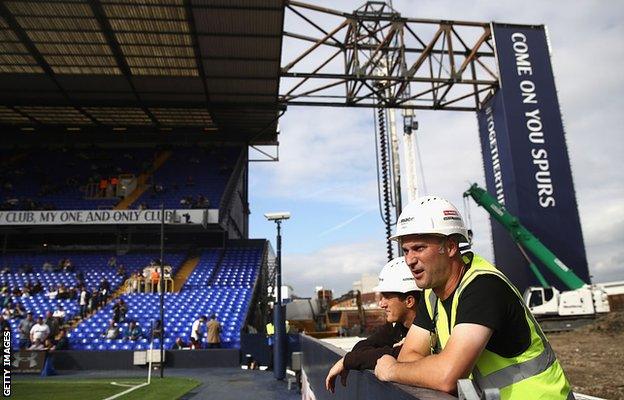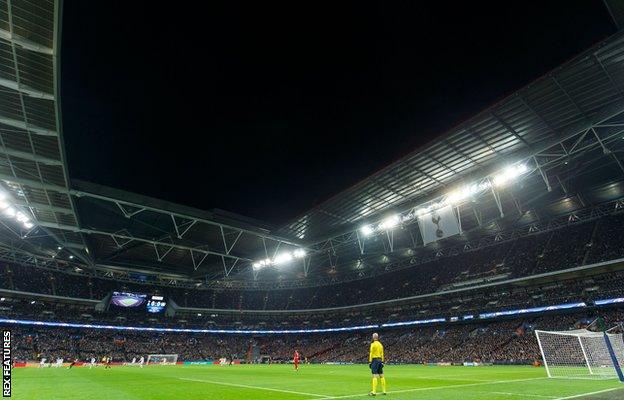Champions League: Is 'Wembley effect' damaging Tottenham in Europe?
- Published
- comments

Tottenham are unbeaten in the league this season but have lost in the EFL Cup and twice in the Champions League
Wembley did not feel like home to Tottenham at the end of their Champions League defeat by Bayer Leverkusen.
Spurs trooped off against a backdrop of thousands of empty red seats and the sound of jeers after a 1-0 loss left them trailing behind Monaco and the Bundesliga side in Group E, their hopes of reaching the knockout stage in serious danger.
It was not meant to be like this when they moved into Wembley as a temporary Champions League home while work continues to transform White Hart Lane into a new stadium.
Can Spurs cope with Wembley?
The evidence of recent results suggests not - a mystery given the magnificent backing their supporters have offered them in these unaccustomed surroundings.
Spurs played in front of 85,011 when they lost to Monaco in September, and Wednesday's crowd was 85,512 - the highest English 'home' attendance.
Yet this loss was their sixth in succession at Wembley, their second in the Champions League. The last time they won at the national stadium was when Juande Ramos' side beat Chelsea 2-1 in the 2008 League Cup final.
And, despite the jeers and empty seats at the end, Spurs cannot point a finger at their fans. They have turned up in record numbers but have been offered nothing in return.
Wembley not to blame - Pochettino
Spurs looked like a team with a flat battery, unable to get going and missing the spark injured striker Harry Kane might have given them, as well as the reliability of defender Toby Alderweireld.
Is it simply unfamiliar surroundings away from the natural comfort of White Hart Lane? Is it Wembley's bigger pitch that makes manager Mauricio Pochettino's trademark intense pressing style more difficult to implement?
The Wembley playing surface is 7,245m², compared with the 6,700m² of White Hart Lane - a difference of 545m², more than the area of two tennis courts.
In the recent win over Manchester City, Spurs were all over Pep Guardiola's side. But they have failed to impose themselves on either Monaco or Leverkusen.
It was only two years ago that Pochettino suggested Spurs would benefit from a bigger pitch, after a surprise home defeat by Newcastle United.
The Argentine said then: "Our style means we need a bigger space to play because we play a positional game. It's true that White Hart Lane is a little bit tight and it's better for an opponent when they play deep."
The evidence of Wembley does not support his theory. Pochettino made no excuses about the surroundings. He placed the blame closer to home.
"We were poor. I have nothing to say about Wembley," he said. After two games at Wembley, both have been poor. It is not an excuse. It is the truth."
Missing home comforts?

Spurs have the option to play all home league and cup matches, as well as any European games, at Wembley during the 2017-18 season while work continues at White Hart Lane
Wembley's opulent surroundings may offer the potential for bigger crowds and more luxurious fixtures and fittings - but are Spurs missing the natural hostility and claustrophobic atmosphere of White Hart Lane?
At their usual home, the steep stands rise from close to the touchline, where supporters can almost reach out and touch the players. They can almost feel the intensity and pace of the game - making it the ideal environment for the style Pochettino demands from his team.
Former Republic of Ireland international Andy Townsend, at Wembley as an expert summariser for BBC Radio 5 live, believes the change in surroundings is having an impact.
He said: "When you play matches at home against top teams in Europe, your advantage is being in familiar surroundings. You can generate an atmosphere. Here at Wembley it is a different surface, different surroundings.
"Tottenham have had only one or two little spells and I think that is the Wembley effect."
Spurs have done their best to make Wembley feel like home, with the club's crests all around the stadium. It is dressed up like Tottenham's home. A giant flag hangs from one of the stadium's towering stands.
Their supporters used camera-phones to light up the stadium before kick-off, and there was no shortage of noise and encouragement once the action got under way. The problems come when Spurs struggle.
Wembley seemed a lonely, unforgiving place as the game went on, almost silent for long periods. Thousands of empty seats also give the stadium a cold feel quicker than it might at White Hart Lane. It was hardly a cauldron as those Spurs fans who stayed until the end attempted to whip up a late rally.
As Pochettino rightly stated, however, the responsibility lies with him and his players. It is up to Spurs to create atmosphere and excitement on this bigger, more forbidding stage, and they have failed miserably twice, first against Monaco and now Bayer Leverkusen.
Does Wembley lift Spurs' opponents?

No English side has kept a clean sheet in the nine Champions League games played at Wembley
If Wembley is a burden to Spurs, what effect is it having on their opponents? The performances of Monaco and Leverkusen suggest it is having more of a galvanising impact on the visitors.
Could it be that performing on this famous stage with all its rich history, albeit in a more modern guise, is providing the sort of inspiration for visiting teams that is damaging Spurs' Champions League ambitions?
It also seems to be inspiring opposition supporters, with the visiting German fans commandeering a corner of Wembley and providing noisy backing throughout their team's excellent victory. They will be aware of the stadium's place in football's folklore and will treat it as a more special occasion than a trip to White Hart Lane.
Monaco looked very much at home in September as they ran out 2-1 winners, establishing a two-goal lead by the 31st minute and surviving in comfort despite Alderweireld pulling a goal back for Spurs right on half-time.
Leverkusen followed suit. They looked more at ease from the kick-off, never appearing under stress and seemingly revelling in Wembley's open spaces.
Wembley was meant to lift Spurs and put pressure on opponents. The reverse has been true.
Wenger's warning coming to pass?

Gabriel Batistuta scored the winner for Fiorentina in their Champions League match against Arsenal at Wembley in 1999
Arsenal manager Arsene Wenger has experience of playing Champions League games at Wembley - bitter experience.
The Gunners made Wembley their Champions League home for two seasons after being forced to reduce the ticket allocation at Highbury by 6,000 between 1998 and 2000.
They failed to get past the group stage either time as they dropped points against Lens, Dynamo Kiev, Fiorentina and Barcelona.
Wenger said in January, looking ahead to the likes of Spurs and Chelsea using Wembley while their stadiums are being rebuilt: "It was a nightmare.
"In hindsight, it was the wrong decision. We decided to go to Wembley but we didn't feel at home. The pitch was bigger, the ground was different and for the English players it was something completely unusual.
"We were used to Highbury, to a tight pitch, and unfortunately we were playing against Dynamo Kiev, who were running everywhere on a very big pitch. It was a disadvantage for sure."
Wenger added: "It is less of a disadvantage now because the stadium is a bit different but the pitch is exactly the same."
It will be of no consolation to Spurs that the words of Arsenal's manager may have provided the signpost to the sort of problems that are casting a giant shadow over their current Champions League campaign.
- Published2 November 2016

- Published26 October 2016
